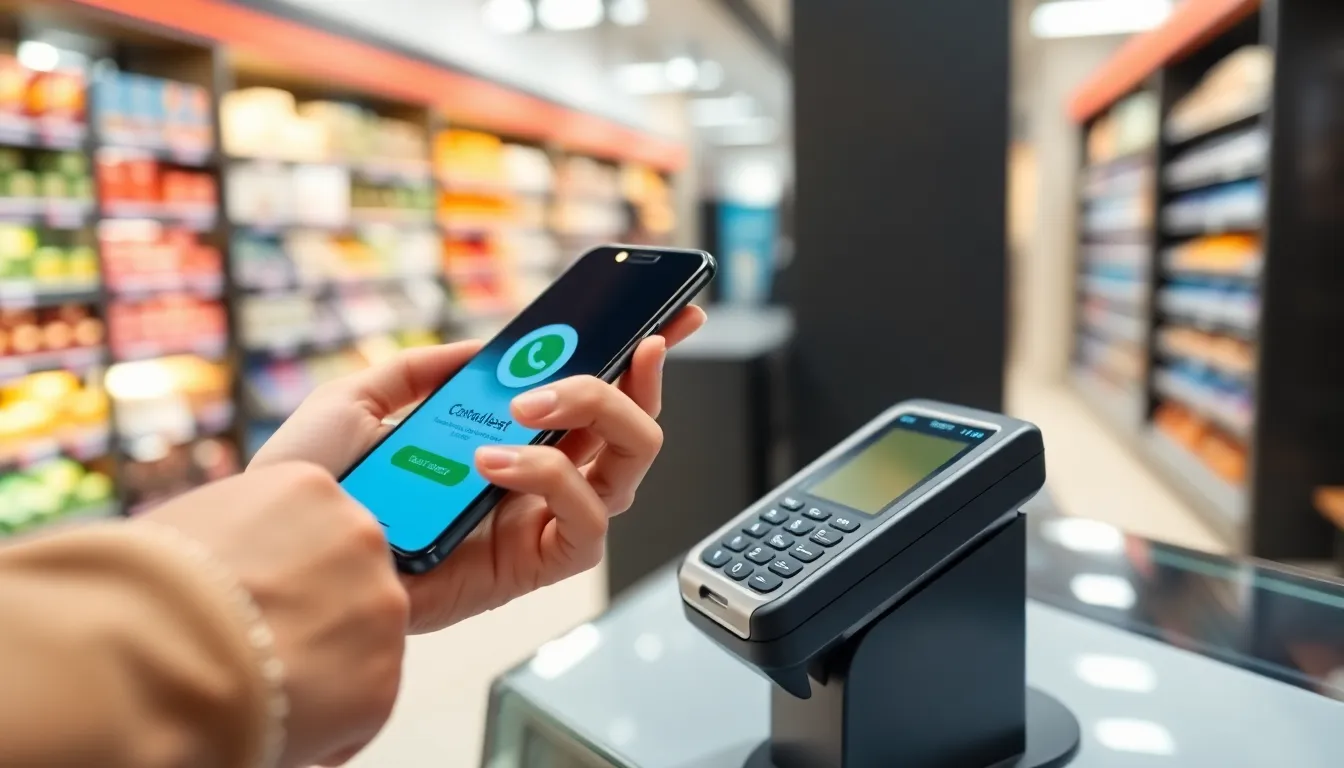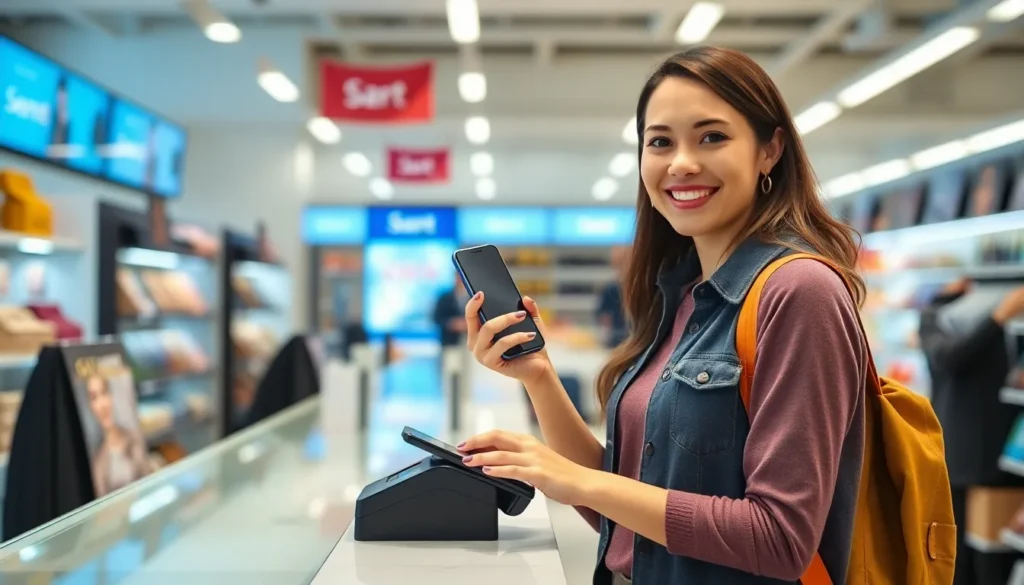In a world where waiting in line feels like a form of punishment, contactless payments swoop in like a superhero to save the day. Imagine breezing through checkout like a VIP, with just a tap of your card or phone. No more fumbling for change or awkwardly trying to swipe a card that just won’t cooperate. It’s time to embrace the future of transactions, where speed and convenience reign supreme.
Table of Contents
ToggleOverview of Contactless Payments
Contactless payments represent a modern approach to transactions. Users complete purchases by simply tapping a card or mobile device near a compatible terminal. This technology operates on Near Field Communication (NFC), allowing secure data transmission over short distances.
Various payment methods support contactless transactions. These include credit cards, debit cards, and mobile wallets like Apple Pay and Google Pay. Transaction security involves encryption, reducing the risk of fraud. Customers enjoy peace of mind knowing their sensitive information remains protected.
Speed plays a crucial role in the growing popularity of contactless payments. Research indicates that transaction times can decrease significantly, sometimes taking less than a second. Businesses benefit as well, experiencing quicker checkout processes and reduced lines.
This payment method is on the rise globally. Statistics show that contactless transactions accounted for approximately 45% of in-person payments in the United States in 2022. Acceptance continues to expand as more retailers invest in the necessary equipment.
User convenience remains a primary factor in the adoption of contactless payments. Shoppers appreciate not having to fumble for cash or inputting a PIN for small purchases. This ease of use contributes to a smoother overall shopping experience.
Overall, contactless payments reshape the landscape of financial transactions. They enhance efficiency and improve customer satisfaction in various settings. As technology evolves, further innovations in contactless payment systems are likely on the horizon.
How Contactless Payments Work

Contactless payments streamline transactions through advanced technology. Users appreciate a quick, secure checkout, which enhances their shopping experience.
Technology Behind Contactless Payments
NFC technology plays a crucial role in enabling contactless payments. This innovative communication method allows devices to exchange data over short distances, typically within four inches. Security features, including encryption and tokenization, protect sensitive information during transactions. Devices such as smartphones and smartwatches often serve as payment platforms. When a user taps their device near a terminal, authentication occurs almost instantaneously, ensuring both speed and security.
Types of Contactless Payment Methods
Various contactless payment methods cater to diverse consumer preferences. Credit and debit cards equipped with RFID technology enable swift transactions at compatible terminals. Mobile wallets like Apple Pay and Google Pay allow users to store multiple payment options on a single device. Smartwatches also support contactless payments, offering a convenient alternative to traditional cards. Retailers increasingly adopt these methods, facilitating faster checkouts and improving customer satisfaction.
Benefits of Contactless Payments
Contactless payments offer distinct advantages that enhance user experiences by streamlining transaction processes.
Convenience and Speed
Convenience stands out as a primary benefit of contactless payments. Users can complete transactions by simply tapping their card or mobile device, significantly reducing time spent at checkout. With transaction times often under a second, shoppers enjoy rapid service without the need for cash handling or PIN entry. Retailers benefit as well, experiencing faster checkouts and increased customer satisfaction. Research indicates that these payments account for approximately 45% of U.S. in-person transactions, reflecting a growing preference among consumers for quicker payment methods.
Security Features
Security remains a critical aspect of contactless payments. These transactions leverage advanced encryption and tokenization technologies, ensuring sensitive data stays protected during transmission. Users can confidently conduct transactions, knowing their information is safeguarded against potential fraud. Each transaction generates a unique code that further mitigates risks associated with unauthorized access. Implementing Near Field Communication (NFC) technology adds another layer of security, making contactless payments not only efficient but also safe for everyday use.
Challenges and Considerations
Various challenges and considerations accompany the rise of contactless payments, despite their benefits.
Transaction Limitations
Transaction limitations pose a challenge for users. Many contactless payment methods enforce a cap on the amount that can be processed in a single transaction. In the U.S., this limit is often set around $50, which can hinder larger purchases. Consumers may need to switch to traditional payment methods for higher amounts, creating a potential inconvenience. Merchants and consumers alike may find these limitations frustrating, especially in scenarios requiring immediate payments. As technology advances, there’s ongoing discussion about raising these limits as security measures improve.
Acceptance by Merchants
Acceptance by merchants illustrates another challenge. While many businesses now support contactless payments, not all are equipped with the necessary technology. Smaller merchants may struggle to invest in upgrading point-of-sale systems. Acceptance can vary widely based on geographic location, affecting consumer preferences for contactless transactions. Additionally, some businesses may hesitate to adopt contactless payments due to concerns about transaction fees associated with these methods. Increasing awareness and investment in technology can help address these issues, ensuring wider acceptance and convenience for consumers.
Future of Contactless Payments
The future of contactless payments promises further advancements and widespread adoption. Emerging technologies, such as biometric authentication, are integrating with existing payment systems to enhance security. More consumers embrace mobile wallets, driving demand for seamless payment experiences.
Research indicates that contactless payment transactions may exceed 60% by 2025, underscoring their increasing prevalence. Retailers are expected to invest significantly in contactless infrastructure, making it a standard feature in brick-and-mortar establishments. Enhanced user experiences are anticipated, with quicker checkout processes reducing wait times at busy locations.
Developments in blockchain technology may also play a role in future contactless payment systems. Such innovations could offer improved security and transparency in transactions, building consumer trust. As contactless payments expand in developing regions, financial inclusion will likely increase, benefiting many unbanked populations.
Challenges remain, particularly regarding transaction limits and merchant acceptance. The average cap around $50 for contactless purchases may require adjustments as consumer trust grows. Acceptance by small businesses often hinges on the associated costs of technology adoption and transaction fees, necessitating changes to promote broader utilization.
The evolution of contactless payments continues to shape the financial landscape. The integration of new technologies and the growing preference for convenient payment methods are undeniable trends. Ongoing improvements in security, combined with efforts to address current limitations, will drive the future of contactless payments.
Contactless payments are transforming the way consumers interact with their finances. Their ability to streamline transactions and enhance user convenience positions them as a preferred choice for many shoppers. As technology continues to evolve the integration of features like biometric authentication will likely further bolster security and ease of use.
Retailers are encouraged to embrace this payment method to keep pace with consumer expectations and improve the overall shopping experience. While challenges like transaction limits and varying merchant acceptance exist addressing these issues will be crucial for widespread adoption.
The future of contactless payments looks promising with predictions of increased utilization and ongoing advancements in security and technology. This evolution will not only benefit consumers but also reshape the retail landscape for years to come.

